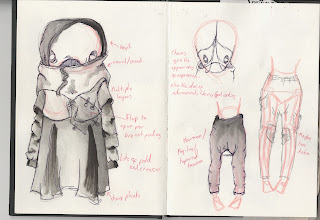I admire her varied use of media while making sure characters do not change drastically.
 |
| Spaceship EE cover slip. (original medium:oil paint) |
Although the majority of the book is done in black and white, the first few pages are done in bright watercolour. This is to exaggerate the spaceship dreamscape that the main character is first seen experiencing.
I love Takano's style of drawing throughout the comic. For me, it seems like it quite a straightforward way of documenting the narrative, as if she is experiencing the situations firsthand.
Another thing I admire too is how the characters still show emotion through movement or slight changes in the face, yet still manage to keep fairly blank and neutral expressions. Some characters have a set expression, usually to show their status in the story and if they are a friend or foe.
What I find really interesting however is the rather extensive guide and glossary that Takano gives at the end of the book. Here characters, creatures and significant objects are identified. There are even explanations for different scene and events throughout the story. Especially when talking about the space and dream-like creatures, this guide seems to turn into a fieldbook, with sketches and notes scrawled around.
 |
| The first double page in the book. (original medium:watercolour/gouache) |
I love Takano's style of drawing throughout the comic. For me, it seems like it quite a straightforward way of documenting the narrative, as if she is experiencing the situations firsthand.
Another thing I admire too is how the characters still show emotion through movement or slight changes in the face, yet still manage to keep fairly blank and neutral expressions. Some characters have a set expression, usually to show their status in the story and if they are a friend or foe.
 |
| Example of a double page. |
What I find really interesting however is the rather extensive guide and glossary that Takano gives at the end of the book. Here characters, creatures and significant objects are identified. There are even explanations for different scene and events throughout the story. Especially when talking about the space and dream-like creatures, this guide seems to turn into a fieldbook, with sketches and notes scrawled around.
 |
| The first page of the Character Guide. |
From my new influence, I gave myself a timed period in which to review my human character appearances.
 |
| A4 page of sketches. |
 |
| Photoshopped colour differences. |
My brief evaluation on is positive. The dark reds/burgundies of the humans help the Nikahrat fade into 'the background' better.
Here are my most recent (and hopefully) final human character designs.
 |
| My new Male and Female characters. |
From these I did similar experiments to what I practiced on Nikahrat, exploring texture and colour.
However, this time I tried a different method.
This is an extra layer for the colour/texture. By roughly using the character line work as a template, I painted in the patterns and colours. The gouache paint brought in its own soft texture. However, I am not sure if something a bit harsher is needed so the humans don't clash with the softness of Nikahrat.
EXPERIMENTS:
 |
| (1) |
These are the three personal favourite experiments. (1) Shows how the line work fits over the colour. The colour doesn't lie true to the lines but I like the effect it gives. It makes it feel very handmade and even has a slight effect of hand-printing too. For (2) I used one of the 'burn' overlays. It doesn't alter the colour or entire image drastically. However, the colour sticks to the darker areas of line work. This works better on the female character because she has more texture detail. Example (3) is my favourite because the colours are so bold and striking against the line work. It really has a hand-painted feel to it. Even though it is technically hand painted, it doesn't look like two separate layers.
 |
| (2) |
 |
| (3) |
These are all screen shots of my photoshop to capture the overlay and layer information and the outcome of the combinations.





Even though I have decided not proceed using these particular experiments, they still look really interesting and I can still use the same effects in different ways.
Inverted colours- Again, the female character benefits more from this effect because she has more line variations. The eyes look especially interesting too.
In this case, I would assume that these characters would be better set in a morbid, sombre setting or in a sci-fi theme.
Whitened lines- In this case the male character benefits more as he has more block colour. However, the stripes on the female's dress and legs make very interesting patterns too.
Inverted with red- This does look similar to the inverted example due to the white lines but here the red paint layer is still kept underneath. However, this overlay inverts any white or light areas, meaning the male's block colours don't show because it is a light wash. Here the eyes and the female's snood and legs take most of the benefit as the colour shows through the white line areas so well.
Extra Experiment-
This was a quick flat colour experiment to see how the possible different shades of red and burgundy would look against a flat colour background.
I went for this dark, murky teal-like colour because it set off the line work and highlighted shading. However, I'm not sure how well it would work against the colours in the Nikahrat palette.










































